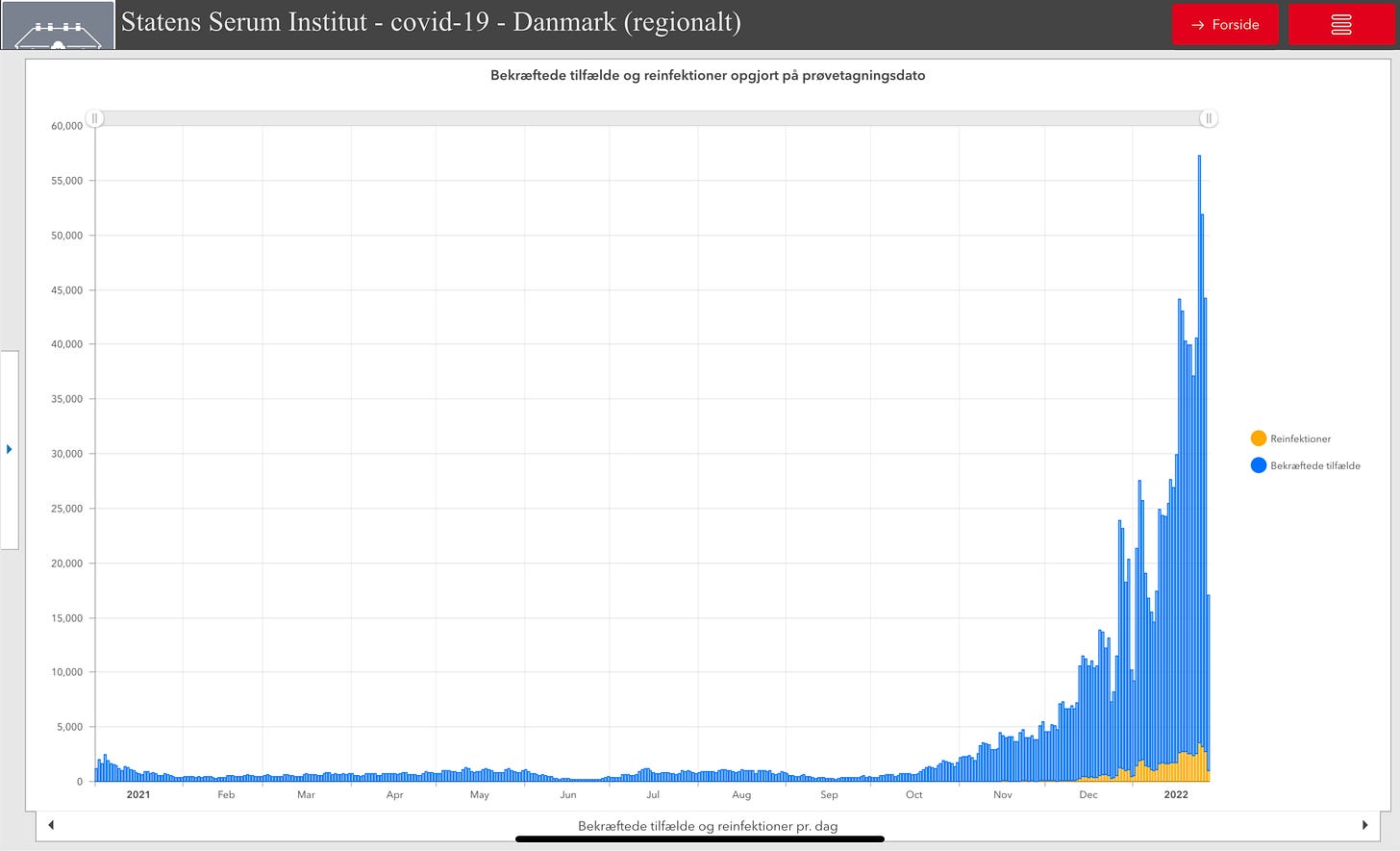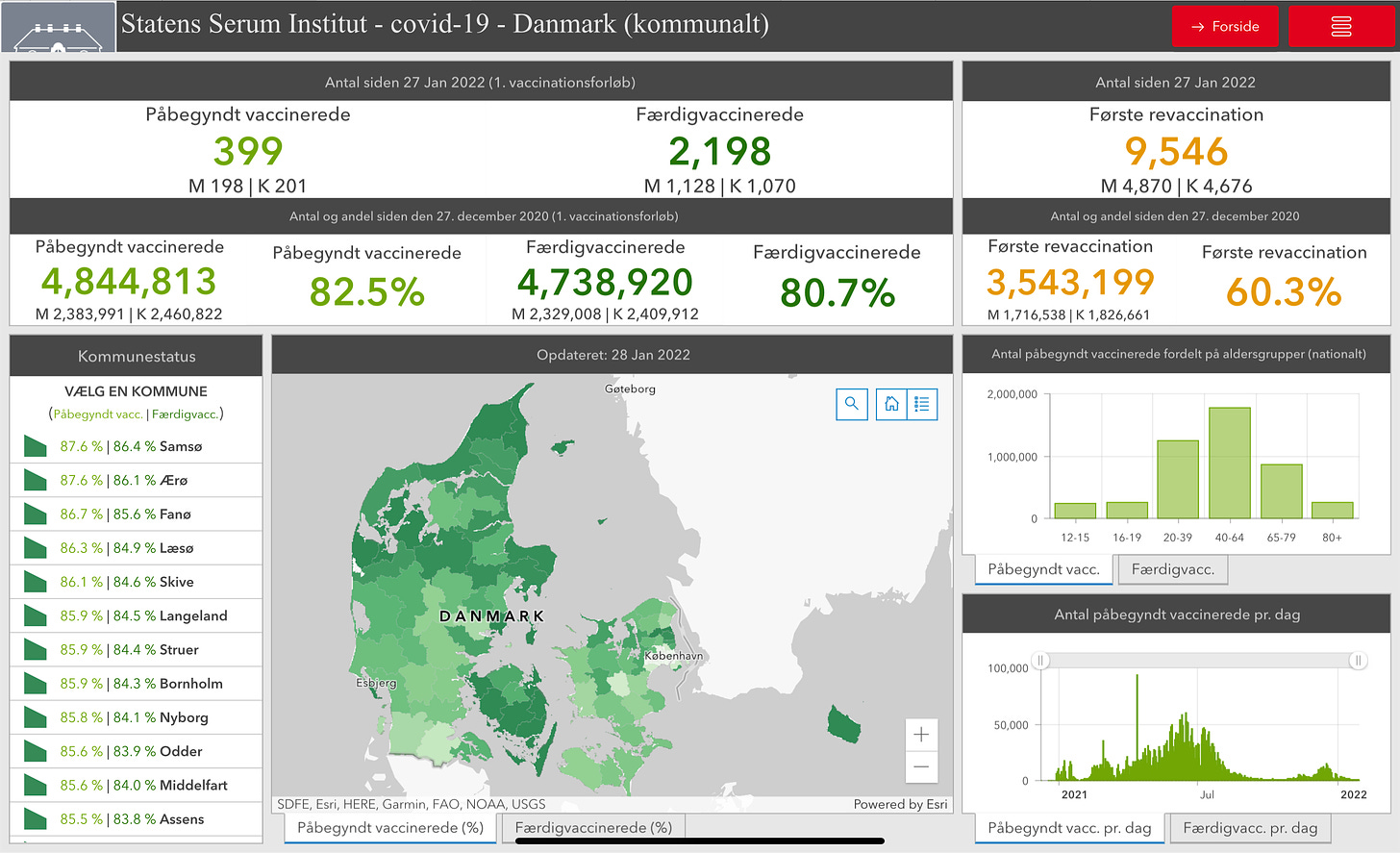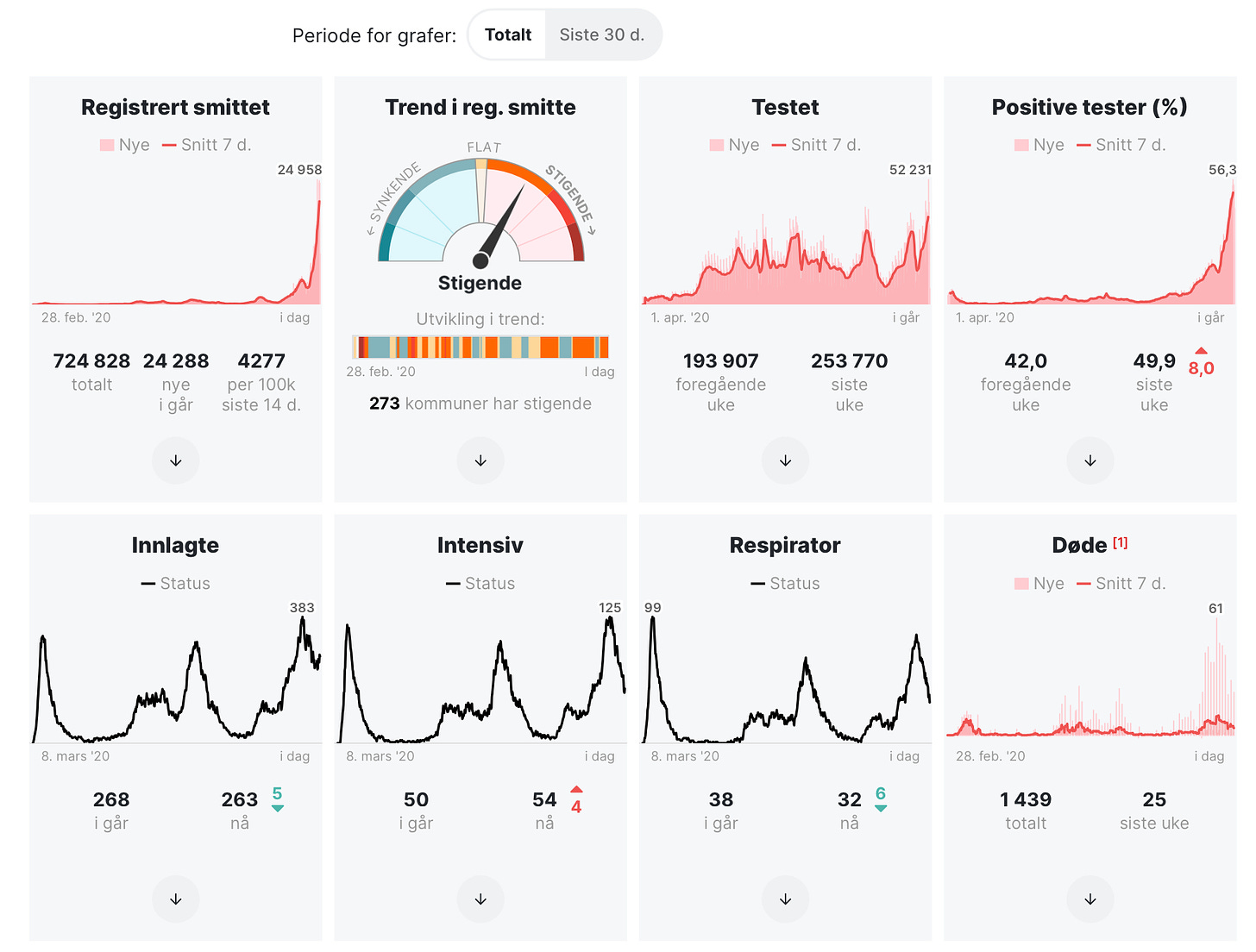The Evening Report - Jan 28
More COVID records fall as Denmark prepares to return to near normal
🇩🇰
More and more people in Denmark are being infected and fewer and fewer are ending up in hospital, according to the latest assessment from the Staten Serum Institut. Infections increased by 56% from the 2nd to 3rd week of January, while the proportion of new hospital admissions due to a coronavirus infection dropped to 60% in week 1. For comparison, the infection increase from the first to second week of January was 35%.
The COVID incidence rate per 100,000 people is rocketing up as well, going from 2,937 in week 2 to 4,572 in week 3.
Unfortunately, it is young people seeing the bulk of the COVID activity. The coronavirus incidence rate in week 3 was a mind-numbing 11,194 per 100,000 among kids aged 12 to 15 years old and trailing right behind them were children 6 to 11 years old with an incidence rate of 10,289.
At the same time, infections have been increasing among nursing home residents.
While children bear the brunt of infections, it is those on the other end of the age spectrum suffering the most coronavirus deaths. The SSI report says while overall fatalities are “relatively stable” with 101 deaths in week 3 compared to 96 in week 2 at the same time, there was a “marked excess mortality” among those 75 years old and older. The increase was especially prevalent through December and into the first week of January. However, the institut says there are signs in the 2nd and 3rd weeks of January that the death rate among seniors may be easing.
While infections skyrocket intensive care admissions are going in the exact opposite direction. ICU admissions dropped to 43 in the third week of January, a decrease of almost 42% from the first week of the new year. Overall admissions due to a COVID infection dropped from 65% in the last week of 2021 to 60% in the first week of 2022.
-
It is a tale of two Omicron’s behind the rapidly rising infection numbers in Denmark. The variant has totally taken over accounting for 99% of all new COVID cases as of January 21.
Omicron is also increasing among hospitalizations. In the third week of January, the variant accounted for 98% of the new COVID admissions, for which the Staten Serum Institut had sequencing results for. Among ICU patients, Omicron was confirmed in 90% of patients who had their positive test results sequenced and returned.
Amid all of this, the Omicron sub-variant BA.2 had become the dominant strain as of the second week of January, and as of week 3, it accounted for 65.37% of infection cases. It accomplished this feat in a matter of weeks showing that it is much more infectious than the already hyper-contagious parent Omicron variant.
-
Denmark ended the week with two record-high daily infections records. It reported 51,033 COVID infections on Thursday, a new daily record at the time, but 24 hours later broke that record with 53,655 infections on Friday.
Reinfections, a positive COVID test 60 days or more after a previous positive test, continue to rise. There were 3,119 reinfections on Thursday and then another 3,263 on Friday.
There were 434,670 total corona tests on Thursday, of which 246,522 were PCR tests equaling a positivity percentage of 21.76%.
-
Denmark’s capital region is seeing the highest COVID incidence rates and positivity percentage. Region Hovedstaden (Metro Copenhagen) has a COVID incidence rate of 5,005 per 100,000 residents and a positivity percentage of 28.6%. Positivity percentages have increased from week to week in all five Danish regions.
-
COVID hospitalizations have reached a record high (967) as numbers keep rising (+12). This breaks the previous hospitalization high of 964, set on January 4, 2021. The number of severely infected people in an ICU (33) continues to drop (-4) and of those on a ventilator (19) numbers have declined as well (-3). COVID admissions to a psychiatric ward (230) continued to rise (+4).
-
On the vaccination front, there were 12,143 inoculations yesterday with most (9,546) being booster doses. Just 399 1st doses were done.
To date, 82.5% of the total population has one dose, 80.7% have two, and 60.3% have a booster dose.
-
Bars and restaurants can return to normal a littler earlier next week. COVID restrictions technically will expire on Monday at midnight. But Denmark Trade and Industry Minister Simon Kollerup has posted to his Facebook page that bars and restaurants can return to normal operating hours as of Monday and will not have to close at 11pm as mandated under the current restrictions. This also applies to the rules around the sale of alcohol.
🇸🇪
Sweden’s infection curve continued its sharp climb with 41,791 infections on Thursday, followed by another 55,180 on Friday. The Swedish Public Health numbers show that a record-high 53,619 of those positive tests were on January 27. Over the last 48 hours there have been 87 corona deaths.
So far, 86.7% of the population 12 years old and older have one dose, 83.6% have two, and of those 18 years old and older, 45.4% have a booster dose.
-
The Swedish Public Health Agency has taken the unusual position of not recommending a general vaccination effort for children 5 to 11 years old. The agency says it came to the decision after consulting with a number of school, pediatric, and other healthcare expert groups. It says the decision “is based on the benefit of the child.”
The agency says the medical benefit of vaccinating young children is “currently small.” Although it sounds like the decision is not carved in stone.
Director Karin Tegmark Wisell:
“We will continue to follow the issue. We are constantly assessing the state of knowledge and the development of the pandemic in Sweden and the rest of the world, and a new position will be taken on this issue before the autumn term.”
The agency claims in its decision that not vaccinating young children “is also not expected to have any major effect on the spread of infection at present, neither in the group of children aged 5–11 nor among other groups in the population.” It says children are a much lower risk of developing severe coronavirus infections and “the younger the child, the lower the risk.”
It is important to note that while a general vaccination program aimed at children 5 to 11 years old has been put on the shelf children in that age group who are deemed to be high-risk or in a vulnerable population have been getting vaccinated since the end of December.
🇫🇮
Finland has registered 11,037 infections and 48 more virus deaths in the last two days.
COVID hospitalizations (641) are down (-34).
So far, 76.3% of the total population has one dose, 73.5% have two, and 42.5% have a booster dose.
-
Finland plans to begin easing COVID restrictions next week. As of February 1, restaurants can remain open until 9pm, but they still have to cut off alcohol sales by 8pm. Things don’t change for bars and pubs who still have to close their doors at 6pm and stop serving booze at 5pm. The Finnish government also recommends that restrictions on sports and cultural activities be relaxed as well, but notes that is the responsibility of regional authorities. The reason behind deciding to ease corona measures is that despite soaring infection numbers, Finland is seeing a steady decrease among severely infected people being admitted to intensive care.
-
There are signs the Omicron-fueled infection wave in Finland may have peaked. The latest situational assessment from the Finnish Institute for Health says there were 52,000 new infections in week 3 compared to 52,000 the week before. The COVID incidence rate per 100,000 continues to rise. The incidence rate over the last two weeks was 1,963 compared to 1,834 for the two weeks before that.
As for hospitalizations, there were 353 patients in specialized healthcare as of January 26, compared to 350 the week prior. The number of those in intensive care has declined from 64 last week to 48 as of Wednesday. There were 33 new COVId admissions to an ICU between January 17 to 23, a sharp decline from 60 and 61 the two preceding weeks.
During the last 14 days, Finland saw 206 more coronavirus deaths, of which 86% were people 70 years old and older.
The institute says unvaccinated continue to be at high risk of a severe coronavirus infection requiring hospitalization and being admitted to an ICU. In the last four months of 2021 people who were not vaccinated were 14 times more likely than a vaccinated person to be hospitalized and 27 times more likely to wind up in intensive care.
In the 3rd week of January, more than 164,000 COVID tests were admitted, of which, according to the health institute, about one-third came back positive. That is roughly in line with the numbers from the previous week.
🇳🇴
Norway added a record high 34,584 infections and had no new virus deaths in the last day.
COVID hospitalizations (263) are down (-5) while the number of severely infected people in an ICU (54) are up (+4) and of those the number on a ventilator (32) dropped (-6).
So far, 80% of Norwegians 12 years old and older have one vaccine dose, 74% have two, and 49.2% have a booster shot.
-
Infection numbers are skyrocketing and hospital admissions are rising as well, according to the latest assessment from the Norwegian Institute for Public Health.
Infection numbers increased by 62% last week compared to the week before and by 154% compared to numbers in the first week of January. All told, there were 117,477 COVID cases last week. That is the highest number of any week in the pandemic so far. The NIPH says those aged six to 19 years old saw the largest increase in new infections.
Norway relies on a large number of COVID self-testing kits and of those only 2.5% reported their results. Of those, the institute says, 32% reported testing positive.
There were 282 new hospital admissions who tested positive last week. Of those, the NIPH says, half (141) were admitted, with the COVID infection being the main reason for hospitalization. The agency says that is a 21% increase week over week and the first time in five weeks the number has increased. By age group, the highest admissions were among those 30 to 44 years old.
ICU numbers edged down last week with 17 intensive care admissions compared to 18 the previous week.
People who were unvaccinated accounted for 29% of those hospitalized, while 28% had two doses and 37% were fully vaccinated with three. The NIPH says of the vaccinated people being admitted, most of them are older and have underlying health conditions.
COVID fatalities appear to be somewhat stable, with 26 last week and 24 the week before that. The institute says the median age of those that died was 82.
🇩🇪
On Thursday, Germany reported a record-high of 203,136 infections and had 188 more pandemic deaths on Thursday. On Friday, it followed that up with another 190,148 new infections and 170 more pandemic deaths.
There were 1,320 more hospitalizations yesterday and ICU numbers (2,274) continue to fall (-89).
To date, 75.7% of the total population has one vaccine dose, 73.8% have two, and 52.2% are boosted.
-
The BA.2 variant is seeing a significant growth advantage over the parent Omicron strain in Germany.
Courtesy of Division Head of the German Cancer Research Cancer Professor Moritz Gerstung/Twitter
🇪🇺🦠
“The pandemic is not over”
That is the message from the European Centre for Disease Prevention and Control as it urges countries across Europe to vaccinate their populations with urgency, tighten up COVID restrictions, and if not already inundated with an Omicron infection wave, to brace for significant pressure on hospitals and across society.
ECDC Director Andrea Ammon is especially emphasizing doing everything possible to get the population vaccinated especially hammering in booster doses.
“Modeling by the ECDC estimates that the uptake of boosters that has been achieved by early January may reduce future Omicron [hospital] admissions by 500,000 to 800,000 across the EU/EEA through restoring higher levels of vaccine protection. And if booster programs are extended to all previously vaccinated individuals, it could reduce admissions by another 300,000 to 500,000.”
Ammon says Omicron infections are spreading across Europe at an “unprecedented speed.” She says they are seeing infection rates three times higher than any previous wave in the pandemic. Getting the unvaccinated populations vaccinated is crucial, according to Ammon, to “successfully enable a transition into what may be a post-acute phase of the pandemic.”
The ECDC Director is also urging European countries to buckle down on COVID restrictions to get through the massive Omicron wave. This includes mask mandates, social distancing, working from home, staying home when sick, frequent hand washing, and having good ventilation of indoor spaces. She says COVID restrictions are “crucial over the immediate future.”
“Countries where Omicron has not yet become dominant, or where it has recently become dominant, should rapidly prepare to face a period of heightened pressure on their healthcare systems and on society as a whole.”
-
The European Centre for Disease Prevention and Control has issued its latest COVID risk assessment map of Europe and once again it is almost entirely high risk deep red.
🇪🇺🦠
The European Medicines Agency has recommended that Pfizer’s COVID treatment pill be approved for use across Europe. The EMA says the antiviral pill called Paxlovid would be for treating adult COVID patients “who do not require supplemental oxygen and who are at increased risk of the disease becoming severe.”
If rubber-stamped by the EU Commission Paxlovid would be the first COVID treatment pill approved for use in Europe.
The EMA says that all reviewed evidence and clinical trials showed Paxlovid significantly reduced COVID hospitalizations and deaths among patients who have underlying health conditions making them a high COVID risk. The agency adds that the safety profile of Paxlovid was “favourable” and side effects were generally mild.
💉
Moderna has begun phase two clinical trials of its Omicron variant specific vaccine as the company announces the first participant in the trial has been dosed.
CEO Stéphane Bancel:
“We are reassured by antibody persistence against Omicron six months after the currently authorized 50 µg booster of mRNA-1273. Nonetheless, given the long-term threat demonstrated by Omicron's immune escape, we are advancing our Omicron-specific variant vaccine booster candidate and we are pleased to begin this part of our Phase 2 study. We are also evaluating whether to include this Omicron-specific candidate in our multivalent booster program. We will continue to share data with public health authorities to help them make evidence-based decisions on the best booster strategies against SARS-CoV-2."
🇨🇦
Canadian Prime Minister Justin Trudeau is in isolation after being exposed to COVID. Reports on Friday say that one of his children had tested positive.
-
Canada reported 18,489 infections on Wednesday and another 18,497 on Thursday while losing another 407 lives to the coronavirus over the last 48 hours. Reminder: due to testing woes across the country infection numbers are likely very underreported.
The Canadian vaccination effort has administered 31,790,860 1st vaccine doses (83.14% of the total population) while 29,942,820 people (78.31%) have two doses, and of those 14,909,036 are fully vaccinated with three doses.
Ontario saw hospitalizations (3,535) drop (-483) while ICU numbers (607) inched down (-1). The province lost another 68 lives to coronavirus. It has a positivity percentage of 16.33%.
Quebec has a positivity percentage of 10.73%. Hospitalizations (3,091) were down (-179) while ICU numbers (228) also dipped (-24). The province lost another 48 lives to the pandemic.
In Newfoundland and Labrador, hospitalizations (20) were unchanged, while ICU numbers (8) crept up (+1). The province has a positivity percentage of 15%.
Nova Scotia hospitalizations (88) inched down (-3) and ICU numbers (15) were unchanged. The province has a positivity percentage of 16.89%. One more person has died.
In New Brunswick there are 141people in hospital (+4) with 8 in an ICU (-3). The province also saw three more deaths.
Manitoba saw hospitalizations (715) dipped (-5) while those in intensive care (52) rose (+3). One more person has died in the province. It has a positivity percentage of 32.1%.
Saskatchewan saw hospitalizations (328) rise (+13) while ICU numbers (35) crept up (+2). The province had two more pandemic deaths. Its positivity percentage is 34%.
Alberta hospitalizations (1,469) reached another record-high (+51) while ICU numbers (106) edged down (-3). The province saw another 14 pandemic deaths. Its positivity percentage is 34%
In B.C. hospitalizations (977) increased (+28) and ICU numbers (141) also edged up (+4). The province had 13 more COVID deaths. Its positivity percentage is 18.21%.
















Thanks Shane!